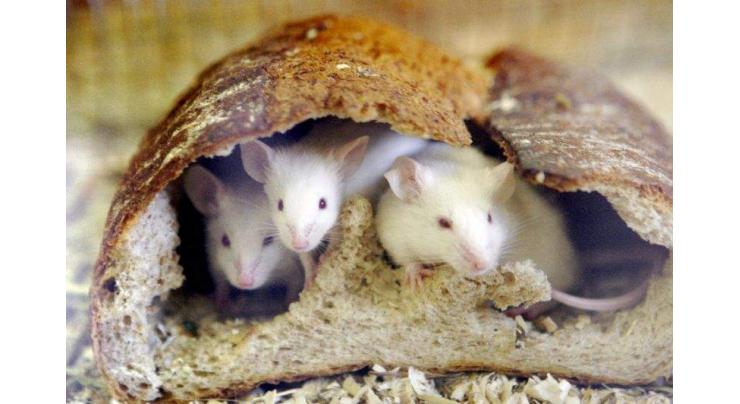
US Scientists Activate Predatory 'kill Switch' In Mice
Mohammad Ali (@ChaudhryMAli88) Published January 12, 2017 | 11:30 PM

MIAMI, , (APP - UrduPoint / Pakistan Point News - 12th Jan, 2017 ) - US scientists have ramped up predatory behaviour in mice by stimulating a region of the brain known for its role in emotions like fear and pleasure, according to a study published Thursday.
The experiment turned the lab mice into super-eating machines, vigorously attacking food, bottle caps, and sticks as prey, said the findings in the journal Cell. However, scientists cautioned that their goal was not to create an army of killer mice.
Rather, it was to better understand how the brain works and perhaps one day improve the treatment of degenerative brain diseases that affect motion and coordination. "A major issue for neuroscientists is how the brain figures out how to respond appropriately to objects in the world," lead author Ivan de Araujo, associate professor of psychiatry at the Yale University school of Medicine, told AFP.
"Predatory behaviour is the perfect model. It is a great window into how the brain solves the problem of how we respond to external stimuli by moving our bodies in an appropriate way." Mice are omnivores, and will eat fruit, vegetables, insects and meat.
They are natural hunters, even though they are more often thought of as prey for larger creatures like snakes, hawks and cats. Researchers decided to see how mice's behavior would change if certain neurons were stimulated using a process called optogenetics, which is also being experimented with to restore muscle movement in people who have been paralyzed, and to treat those with epilepsy or Parkinson's disease.
Using an implantable brain device and a laser to activate certain neurons in the part of the brain known as the amygdala, researchers found two different pathways to changing a lab mouse's behavior -- one that triggered the animal's pursuit of prey, and another that signaled it to bite and kill.
"We could make them more efficient hunters in the sense that they would spend less time to be able to capture live prey and subdue it and kill it," said Araujo.
"Perhaps more strikingly, when we used a bug made of plastic that was moving around the cage, we could make the animals pursue an object that they would normally avoid," he added.
"We triggered the behavior toward objects that were not live prey." The amygdala is an almond-sized region of the temporal lobe known for its role in emotions like fear and pleasure, as well as motivation and survival instincts.
- Not killing machines - ======================== However, researchers also noted that when other mice were included in the experiments, they did not attack each other. "I wouldn't like people to think that this could be used for generating aggression," Araujo said.
"In fact, I don't think this is actually possible. I think the behavior is very specific to looking for food. They showed no interest in attacking things that are as large as they, or other mice." The brain stimulation only worked under the control of lab technicians, and if any of the mice were to escape, they would likely soon become another animal's meal, he said.
"We are uncovering brain areas that weren't known before to have a direct relationship to muscle activity," explained Araujo. "Over the long term, I expect this would help us understand why motor disease and degeneration affect mastication (chewing) and swallowing, which are very traumatic effects of motor diseases in people." Asked for comment on the study, psychiatrist Monica Michell of Lenox Hill Hospital in New York said what is new about the research is how it delineates the exact pathways for predatory behavior, and that its location is in the amygdala was "not all that surprising." "Anybody who has a dog knows that no matter how well-fed they are, if they see a squirrel they will run," she said.
"In terms of humans, it sort of confirms what we have been believing for a while -- that the amygdala is involved in emotions and that aggressive behavior is hard-wired and part of our makeup."
Recent Stories

Punjab CM inaugurates Pakistan’s first Virtual Women Police Station

Dutch model Donny Roelvink embraces Islam

Experts raise concerns over introduction of 10-stick packs

Iranian president arrives in Karachi

Law Minister expresses Govt's resolve to address issue of missing persons

Rizwan’s batting order may be changed: Sources

Nawaz Sharif to visit Guangzhou exhibition in China

FM Dar not traveling to China: Foreign Office

PM takes notice of deliberate delay in tax cases

Iranian President visits Allama Iqbal’s mausoleum

Iranian President arrives in Lahore today

Currency Rate In Pakistan - Dollar, Euro, Pound, Riyal Rates On 23 April 2024
More Stories From World
-
Migrant boat capsizes off Djibouti leaving 21 dead
30 minutes ago -
Tesla profits tumble 55% as EV sales under pressure
30 minutes ago -
Talks on global plastic treaty begin in Canada
1 hour ago -
Migrant deportations loom after parliament passes UK-Rwanda plan
2 hours ago -
Macron in last-ditch bid to halt EU vote battering
2 hours ago -
Ukraine moves to bring military-aged men home to fight
3 hours ago
-
Asia hit hardest by climate change, extreme weather: UN weather agency
3 hours ago -
Muscles and masterpieces: Louvre offers Olympic sport sessions
3 hours ago -
Migrant boat capsizes off Djibouti leaving 16 dead
3 hours ago -
UK Rwanda law sparks fear among migrants hoping to cross Channel
5 hours ago -
China issues highest-level rainstorm warning after deadly floods
5 hours ago -
UK's Sunak announces raised defence spending, new Ukraine aid
6 hours ago